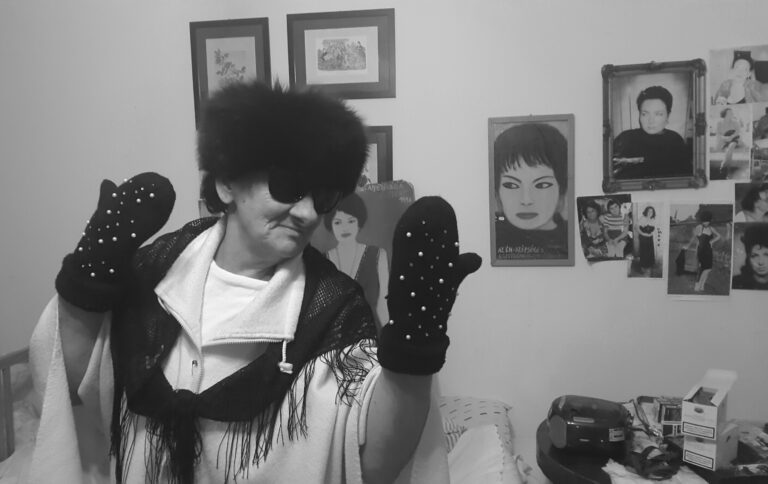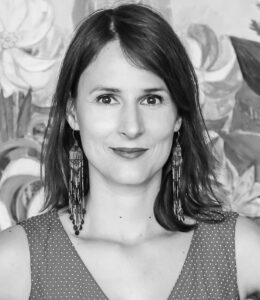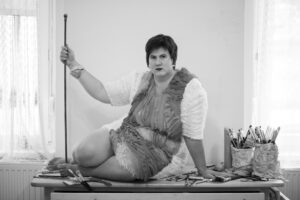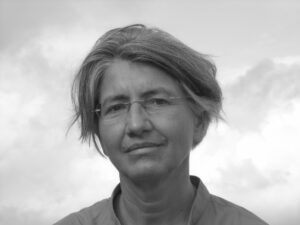Mara Oláh Omara

– born 1945, died 2020 – is the best-known Hungarian Roma artist who has long been considered a naive painter. In addition to her socially critical paintings, her performances, public exposures, outspoken statements and provocative appearances are an integral part of her oeuvre, and can be interpreted as a peculiar feminist attitude, a struggle for Roma emancipation. Omara has participated in many exhibitions in Hungary and abroad. In 2004, she took part in the group exhibition “The Hidden Holocaust” at Kunsthalle Budapest (Műcsarnok). In 2007 she exhibited in the first Roma pavilion of the Venice Biennale, and in 2009, her works were featured in an international context at the representative exhibition “Gender check. Femininity and Masculinity in the Art of Eastern Europe” hosted by MUMOK, Vienna. Her solo shows include “The Jewelry of One-Eyed Omara is Only Visible With a Magnifying Glass” (2011) at the Liget Gallery and “Think What You Want” realized with her active participation in aqb Project Space (2017). Omara lived in a house she called “luxury shack”, and that she built with her own means with a “swimming pool” in Szarvasgede. She died on March 24, 2020, at the age of 75.
As an uneducated artist, I became a naive painter, but the real reason for my recognition lies in my Roma identity. If I did not experience on my own skin the minutes, days, years that only a gypsy could experience, I would be a dreary painter. If I didn’t experience a lot of humiliation, shaming, disdain, hatred, there would not be this otherness in my paintings that makes me unique. With all my pictures, I want to express emotions, tell stories, fight for freedom against injustice. – Omara
Mara Oláh worked as a cleaning lady when she started painting at the age of forty-three as a pretext of overcoming a headache caused by cramps. It is in such a crisis in my life, after the sudden death of my mother, that I started to paint in 1988. I felt fatal head cramps. On one day I had cramps again and asked my little girl for paper and pencil because I felt I had to draw. That’s when my painting started, because by the time I was done with the drawing that depicted Sophia Loren, my head cramps were gone as if they never existed. During her lifetime, she suffered from several serious illnesses, and her left eye had to be removed. She showed the work depicting her eye surgery1 to the professionals of the Hungarian National Gallery in 1991, where, according to her biography2, she received positive feedback and encouragement to carry on with art. In 1993, she created Mara Gallery, the first private Roma gallery in Hungary in her apartment in Budapest. From the beginning, she built her artistic career with extraordinary talent and instinctive professionalism, and was aware of the mechanisms operating the art world, in which she moved with extravagant ease3.
Since 1992, she has been including texts in her paintings so that the scenes she depicts are not ambiguous and misinterpreted4. At her exhibition in Szeged, one of her paintings was exhibited with the title “Mara is resting”, however it depicted Mara standing on her knees looking for her artificial eye lost at a funeral. A two-figure painting depicting Omara and her sister was titled “Lesbians”. After learning what the word lesbian means from the organizer of the exhibition, Mara “in her indignation, also painted a picture of lesbians as a gift to the curator”.
The birth of her child in 1967 was a defining event of her life and an important source of inspiration for her works. She realized hundreds of portraits of her daughter and even painted various events of her private life56. In addition, she dealt with her own motherhood, her ambivalent experiences of childbirth, breastfeeding, childcare, and parenting in many of her paintings. I paint the story of my life, which consists of a series of conflicts. I do not only paint conflicts though, but also the wonder of what it is to be a Roma mother. Most people don’t want to believe that there is nothing more beautiful in the world than being a mother.
Her paintings depict her own life story and are imprints of her cumulative minority status, of the hardships she has experienced as a poor, Roma woman, and as a solo mother. In her narrative paintings, she expresses the offences she faced, the discrimination she suffered from, while speaking about the fate of the Roma minority and on behalf of the entire minority. Her social critique unveils the prejudiced thinking of the majority society, systemic exclusion and humiliation.
The paintings in blue colour with texts that expose the shocks that Roma and women experience as minorities appeared in her oeuvre in 1997. Eight paintings from her so-called blue series that depicts determining and traumatic events of her life became part of the collection of the Ludwig Museum – Museum of Contemporary Art7. The recurring theme of her works is marriage to a non-Roma man and the family conflicts and tensions resulting from it – Even then, I felt that the one I love is not for me, 1962 (2000); My Daughter’s Wedding, 1989 (2001). In her paintings she speaks about the Roma-peasant opposition (this is how she calls the members of the majority society) that stems from cultural differences, and criticizes sharply8 the discrimination the differentiated treatment that (male) representatives of the authority (police, school director, doctor, mayor, councillor) inflict to Roma people, and their abuse of power – Immediate disciplinary procedure (1998); Mara and the policeman (1972). The various existential stages of her life, her relocations, and her living conditions9 also constitute recurring themes in her paintings – Mara moves to Gönyü, no one helped, 1996 (2000).
Her expressive paintings characterized by the use of red and blue colours, fully filled image surfaces and intuitive compositions are completed with thickly written(painted) texts covering them. In addition to oil paintings, she also made peculiar miniature paintings on found materials such as packs of cigarette and matchboxes10 – the smallest image measures 1×1 cm, the largest only 5×2,5 cm.
Miniatures are born at a terrific speed – tens, hundreds – they can now be counted in thousands. Most of the time, I don’t start painting as planned, I just suddenly have a craving for it, so I don’t waste time on preparations. I often paint on small pieces of paper cut out of anything, the lid of a matchbox, the side of a cigarette box that just gets in my hands.11
The most comprehensive theoretical interpretation of her art can be read in Tímea Junghaus’ essay entitled Epistemic disobedience. Omara’s Decolonized Blue Series12. Omara’s work was taken care of by art historian László Beke, artist and friend János Sugár, cultural researcher Andrea Pócsik and curator-gallerist Péter Bencze, among others. Her legacy is currently handled by Everybody Needs Art. Omara lived in a house she called “luxury shack”13, and that she built with her own means with a “swimming pool”14 in Szarvasgede.
Video documentation of Omara’s works.
This text is based on the autobiography on Omara’s artist website, on the interviews made with her, on the self-published book The Gypsy Mother Deserves a Crown, as well as on web sources, and was compiled by art historian Viktória Popovics (2021).
1See: http://www.omara.hu/kepek.html#14.2See: http://www.omara.hu/eletrajz.html.
3See: http://www.omara.hu/kepek.html#30.
4Image: Mara Oláh Omara, Ezt hitték és kiöntötték az isteni házityúkot [This is what they thought and poured out the delicious hen soup], oil on fibreboard, 12 x 8 cm. Everybody Needs Art Collection. Courtesy the Omara Archive and Everybody Needs Art, Budapest.
5Image: Mara Oláh Omara, Óvoda [Kindergarten], 1988, oil on fibreboard, 55 x 80 cm. Courtesy the Omara Archive and Ludwig Museum - Museum of Contemporary Art, Budapest. Courtesy the Omara Archive and Ludwig Museum - Museum of Contemporary Art, Budapest.
6Image: Mara Oláh Omara, Lányom esküvője [Wedding of my daughter], 1989, oil on fibreboard, 53 x 73 cm. Courtesy the Omara Archive and Ludwig Museum - Museum of Contemporary Art, Budapest.
7See: https://www.ludwigmuseum.hu/en/author/olah-mara.
8Image: Mara Oláh Omara, Azonnali fegyelmi eljárás [Immediate disciplinary procedure], 1998, oil on fibreboard, 60 x 90 cm. Courtesy the Omara Archive and Ludwig Museum - Museum of Contemporary Art, Budapest. See also: http://www.omara.hu/kepek.html#22.
9See: http://www.omara.hu/kepek.html#79.
10see: http://www.omara.hu/kepek.html#29.
11See: https://olah-mara-miniatur-festmenyei.webnode.hu/.
12Tímea Junghaus: Az episztemikus engedetlenség. Omara dekolonializált Kék sorozata [Epistemic disobedience. Omara’s Decolonized Blue Series], [in:] ”Ars Hungarica”, 2013. volume XXXIX (#3), pp. 302-318.
13Image: Mara Oláh Omara. Courtesy the Omara Archive and Everybody Needs Art, Budapest.
14See: http://www.omara.hu/kepek.html#75.
– szül. 1945 – elhunyt 2020 – a legismertebb magyar roma művész, akit sokáig naiv festőnőként tartottak számon. Társadalomkritikus festményei mellett performanszai, nyilvános szereplései, szókimondó megnyilatkozásai és provokatív megjelenése szerves részét képezik életművének, sajátos feminista attitűdként, a roma emancipációért való küzdelemként értelmezhető. Számos hazai és nemzetközi kiállításon vett részt. 2004-ben szerepelt a budapesti Műcsarnok “Elhallgatott holokauszt” c. csoportos kiállításán. 2007-ben kiállított a Velencei Biennálé első roma pavilonjában, 2009-ben pedig a bécsi MUMOK ”Gender check. Feminity and Masculinity in the Art of Eastern Europe” c. reprezentatív kiállításán nemzetközi kontextusban kerültek művei. Egyéni kiállításai közül kiemelkedik a “Csak nagyítóval lehet megnézni az egyszemlátó Omara ékszereit” c. bemutatkozása a Liget Galériában (2011), valamint a művész aktív közreműködésével létrejött nagyszabású tárlata „Gondolj amit akarsz” címmel az aqb Project Space-ben (2017).
Szarvasgedén, az általa „luxusputrinak” nevezett, nagyrészt saját erőből létrehozott „úszómedencés” házában élt. 2020. március 24-én, életének 75. évében hunyt el.
Tanulatlan alkotóként lettem naiv festő, de elismertté válásom valódi oka a cigányságomban rejlik. Ha nem tapasztalom meg saját bőrömön azokat a perceket, napokat, éveket amiket csak egy cigány élhet meg, akkor sivár piktor lennék. Ha nem élem át a sok megaláztatást, megszégyenítést, megvetést, gyűlöletet, akkor nincs az a másság a képeimben amitől egyedi lehetek. Minden képemmel érzelmeket akarok kifejezni, történeteket elmesélni, szabadságharcot vívni az igazságtalanság ellen. – Omara
Oláh Mara takarítónőként dolgozott, amikor negyvenhárom éves korában egy görcsös fejfájás leküzdése ürügyén kezdett festeni. Életemnek egyik ilyen válságos időszakában, anyám hirtelen halála után, 1988-ban kezdtem el festeni. Végzetes fejgörcsöket éreztem. Egy ilyen fejgörcsös napon papírt és ceruzát kértem a kislányomtól, mert úgy éreztem, hogy rajzolnom kell. Ekkor kezdődött el a festészetem, mert mire készen lettem a képpel, ami Sophia Lorent ábrázolta, a fejgörcseim elmúltak, mintha nem is lettek volna. Élete során több súlyos betegségen is átesett, bal szemét el kellett eltávolítani. Szemműtétét1 ábrázoló munkáját 1991-ben megmutatta a Magyar Nemzeti Galéria munkatársainak, ahol életrajza szerint2 pozitív visszacsatolást kapott, az alkotás folytatására biztatták. 1993-ban budapesti lakásán létrehozta az első magyarországi cigány magángalériát Mara Galéria néven. A kezdetektől fogva rendkívüli érzékkel és ösztönös profizmussal építette művészi karrierjét, tudatában volt a művészeti világ működési mechanizmusainak, melyben extravagáns könnyedséggel mozgott3.
1992 óta festményeit szövegekkel látta el annak érdekében, hogy az általa ábrázolt jelenetek ne legyenek félreérthetőek és félreértelmezhetőek4. Szegedi tárlatán ugyanis azt a képét, amelyen Mara egy temetésen a sírástól kiesett műszemét négykézlábra ereszkedve keresi a fűben, “Mara pihen” címmel mutatták be. Egy kétalakos, Omarát és nővérét bemutató festményét pedig “Leszbikusok” címmel láttak el. Mara, miután a kiállítás szervezőjétől megtudta, mit jelent a leszbikus szó, felháborodásában festett is egy leszbikusokat ábrázoló képet ajándékba a kurátornak.
Életének meghatározó eseménye és alkotásainak fontos inspirációs forrása 1967-ben született gyermeke, akiről több száz portrét készített, sőt lánya magánéletének különböző eseményeit is megfestette56. Emellett számos festményben dolgozta fel saját anyaságát, a szülés, a szoptatás, a csecsemőgondozás és a gyermeknevelés ambivalens tapasztalatait. Én az életem történetét festem, ami egy sor konfliktusból áll. De nem csak a konfliktusokat festem, hanem azt a csodát is, hogy mi az, cigány-anyának lenni. A legtöbben nem akarják elhinni, hogy az egész világon nincs szebb annál, mint anyának lenni.
Saját élettörténetét feldolgozó képei a halmozottan kisebbségi lét, szegényként, romaként, nőként, anyaként átélt megpróbáltatások lenyomatai. Narratív festményein az általa elszenvedett sérelmeknek, az őt ért diszkriminációnak ad hangot, miközben a cigány kisebbség sorsáról és az egész kisebbség nevében beszél. Társadalomkritikája lerántja a leplet a többségi társadalom előítéletes gondolkodásáról, a rendszerszinten kódolt kirekesztésről és megaláztatásról.
A roma és a női kisebbségi lét megrázkódtatásairól szóló kék színnel festett és feliratokkal ellátott képek 1997-ben jelentek meg életművében. Ún. kék sorozatának nyolc festménye bekerült a Ludwig Múzeum – Kortárs Művészeti Múzeum7 gyűjteményébe, melyeken életének meghatározó és megrázó eseményei elevenednek meg. Műveinek visszatérő témája a nem cigánnyal kötött házasság, és az ebből adódó családi konfliktusok és feszültségek. (Már akkor éreztem, hogy akit szeretek, nem hozzám való, 1962 (2000; Lányom esküvője, 1989 (2001). Festményein nemcsak a kulturális különbségekből adódó cigány-paraszt (így nevezi a többségi társadalom tagjait) szembenállást, hanem a hatalom (férfi) képviselőinek (rendőr, iskolaigazgató, orvos, polgármester, tanácselnök) romákkal szemben tanúsított megkülönböztetett bánásmódját, a hatalmukkal való visszaélést is élesen kritizálja8. Életének különböző egzisztenciális állomásai, költözései, lakhatási körülményei9 is gyakori képtémái közé tartoznak (Mara Gönyüre cserél, senki nem segített, 1996 (2000).
Expresszív festményein a vörös és kék színek dominálnak, a teljesen kitöltött képfelületeit, intuitív kompozícióit a vastagon írt(festett), gyakran mindent beborító szövegek teszik teljessé. Az olajképek mellett talált anyagokra, cigarettás és gyufásdobozokra10 különleges miniatűr képeket is festett (A legkisebb kép mérete 1 cm x 1 cm, de a legnagyobb is csak 5 cm x 2,5 cm).
A miniatűrök szédületes sebességgel születnek – tízesével, százasával – most már ezrekben lehet mérni őket. A legtöbbször nem tervezetten kezdek festeni, hanem csak hirtelen rám tör a vágy, így nem áldozok időt az előkészületekre. Gyakran festek bármiből kivágott apró papírdarabokra, gyufaskatulya fedelére, cigarettásdoboz oldalára, ami éppen a kezembe akad.11
Művészetének legátfogóbb elméleti értelmezése Junghaus Tímea Az episztemikus engedetlenség. Omara dekolonializált Kék sorozata12 c. tanulmányában olvasható. Omara munkásságával többek között Beke László művészettörténész, a művész-barát Sugár János, Pócsik Andrea kultúrakutató és Bencze Péter kurátor-galériás foglalkoztak. Hagyatékát jelenleg az Everybody Needs Art gondozza. Szarvasgedén, az általa „luxusputrinak”13 nevezett, nagyrészt saját erőből létrehozott „úszómedencés”14 házában élt. 2020.
Videódokumentációk. A szöveg Omara művészeti honlapján található önéletrajzon, a vele készült interjúkon, a Cigány anyának korona jár című saját kiadású könyvén, valamint internetes forrásokon alapszik.
Összeállította: Popovics Viktória művészettörténész (2021).
1lásd: http://www.omara.hu/kepek.html#14.2lásd: http://www.omara.hu/eletrajz.html.
3lásd: http://www.omara.hu/kepek.html#30.
4kép: Oláh Mara Omara, Ezt hitték és kiöntötték az isteni házityúkot, olaj, farost, 12 x 8 cm. Az Everybody Needs Art gyűjteménye. Az Omara Archívum és az Everybody Needs Art jóvoltából.
5kép: Oláh Mara Omara, Óvoda, 1988, olaj farost, 55 x 80 cm. Az Omara archívum és a Ludwig Múzeum - Kortárs Művészeti Múzeum jóvoltából. Az Omara archívum és a Ludwig Múzeum - Kortárs Művészeti Múzeum jóvoltából.
6kép: Oláh Mara Omara, Lányom esküvője, 1989, olaj farost, 53 x 73 cm. Az Omara archívum és a Ludwig Múzeum - Kortárs Művészeti Múzeum jóvoltából.
7lásd: https://www.ludwigmuseum.hu/en/author/olah-mara.
8kép: Oláh Mara Omara, Azonnali fegyelmi eljárás, 1998, olaj farost, 60 x 90 cm. Az Omara archívum és a Ludwig Múzeum - Kortárs Művészeti Múzeum jóvoltából. Lásd: http://www.omara.hu/kepek.html#22.
9lásd: http://www.omara.hu/kepek.html#79.
10lásd: http://www.omara.hu/kepek.html#29.
11lásd: https://olah-mara-miniatur-festmenyei.webnode.hu/.
12Junghaus Tímea, Az episztemikus engedetlenség. Omara dekolonializált Kék sorozata, [in:] “Ars Hungarica”, 2013. XXXIX(évf. 3). szám, pp. 302-318.
13kép: Oláh Mara Omara, Az Omara Archívum és az Everybody Needs Art jóvoltából.
14lásd: http://www.omara.hu/kepek.html#75.


